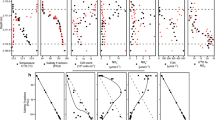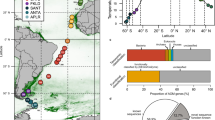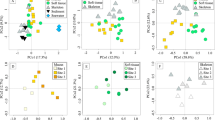Abstract
Oceanic microbial diversity covaries with physicochemical parameters. Temperature, for example, explains approximately half of global variation in surface taxonomic abundance. It is unknown, however, whether covariation patterns hold over narrower parameter gradients and spatial scales, and extending to mesopelagic depths. We collected and sequenced 45 epipelagic and mesopelagic microbial metagenomes on a meridional transect through the eastern Red Sea. We asked which environmental parameters explain the most variation in relative abundances of taxonomic groups, gene ortholog groups, and pathways—at a spatial scale of <2000 km, along narrow but well-defined latitudinal and depth-dependent gradients. We also asked how microbes are adapted to gradients and extremes in irradiance, temperature, salinity, and nutrients, examining the responses of individual gene ortholog groups to these parameters. Functional and taxonomic metrics were equally well explained (75–79%) by environmental parameters. However, only functional and not taxonomic covariation patterns were conserved when comparing with an intruding water mass with different physicochemical properties. Temperature explained the most variation in each metric, followed by nitrate, chlorophyll, phosphate, and salinity. That nitrate explained more variation than phosphate suggested nitrogen limitation, consistent with low surface N:P ratios. Covariation of gene ortholog groups with environmental parameters revealed patterns of functional adaptation to the challenging Red Sea environment: high irradiance, temperature, salinity, and low nutrients. Nutrient-acquisition gene ortholog groups were anti-correlated with concentrations of their respective nutrient species, recapturing trends previously observed across much larger distances and environmental gradients. This dataset of metagenomic covariation along densely sampled environmental gradients includes online data exploration supplements, serving as a community resource for marine microbial ecology.
Similar content being viewed by others

Log in or create a free account to read this content
Gain free access to this article, as well as selected content from this journal and more on nature.com
or
Accession codes
References
Abubucker SS, Segata NN, Goll JJ, Schubert AAM, Izard JJ, Cantarel BBL et al. (2012). Metabolic reconstruction for metagenomic data and its application to the human microbiome. PLoS Comput Biol 8: e1002358–e1002358.
Anderson MJ . (2001). A new method for non-parametric multivariate analysis of variance. Austral Ecol 26: 32–46.
Anderson MJ, Gorley RN, Clarke KR . (2008) PERMANOVA+ for PRIMER: Guide to Software and Statistical Methods. PRIMER-E Ltd: Plymouth, UK.
Barberán A, Fernández-Guerra A, Bohannan MBJ, Casamayor EO . (2012). Exploration of community traits as ecological markers in microbial metagenomes. Mol Ecol 21: 1909–1917.
Churchill JH, Bower AS, McCorkle DC, Abualnaja Y . (2014). The transport of nutrient-rich Indian ocean water through the Red Sea and into coastal reef systems. J Mar Res 72: 165–181.
Coleman ML, Chisholm SW . (2010). Ecosystem-specific selection pressures revealed through comparative population genomics. Proc Natl Acad Sci USA 107: 18634–18639.
DeLong EF, Preston CM, Mincer T, Rich V, Hallam SJ, Frigaard N et al. (2006). Community genomics among stratified microbial assemblages in the ocean’s interior. Science 311: 496–503.
Dinsdale EA, Edwards RA, Hall D, Angly F, Breitbart M, Brulc JM et al. (2008). Functional metagenomic profiling of nine biomes. Nature 452: 629–632.
Eddy SR . (2011). Accelerated profile HMM searches. PLoS Comput Biol 7: e1002195.
Edgar RC . (2010). Search and clustering orders of magnitude faster than BLAST. Bioinformatics 26: 2460–2461.
Edwards FJ . (1987). Climate and oceanography. In: Edwards AJ, Head SM. (eds). Key Environments: Red Sea. Pergamon: Oxford, pp 45–68.
Feingersch R, Suzuki MT, Shmoish M, Sharon I, Sabehi G, Partensky F et al. (2010). Microbial community genomics in eastern Mediterranean Sea surface waters. ISME J 4: 78–87.
Feingersch RR, Philosof AA, Mejuch TT, Glaser FF, Alalouf OO, Shoham YY et al. (2012). Potential for phosphite and phosphonate utilization by Prochlorococcus. ISME J 6: 827–834.
Ghai R, Martin-Cuadrado A-B, Molto AG, Heredia IG, Cabrera R, Martin J et al. (2010). Metagenome of the Mediterranean deep chlorophyll maximum studied by direct and fosmid library 454 pyrosequencing. ISME J 4: 1154–1166.
Gianoulis TA, Raes J, Patel PV, Bjornson R, Korbel JO, Letunic I et al. (2009). Quantifying environmental adaptation of metabolic pathways in metagenomics. Proc Natl Acad Sci USA 106: 1374–1379.
Gilbert JA, Steele JA, Caporaso JG, Steinbrück L, Reeder J, Temperton B et al. (2011). Defining seasonal marine microbial community dynamics. ISME J 6: 298–308.
Gruber N . (2008). The marine nitrogen cycle: overview and challenges. In: Capone DG, Bronk DA et al (eds). Nitrogen in the Marine Environment. Elsevier: Oxford.
Haroon MF, Thompson LR, Parks DH, Hugenholtz P, Stingl U . (2016). A catalogue of 136 microbial draft genomes from Red Sea metagenomes. Sci Data e-pub ahead of print 5 July 2016 doi:10.1038/sdata.2016.50.
Hurvich CM, Tsai C-L . (1989). Regression and time series model selection in small samples. Biometrika 76: 297–307.
Hutter B, Dick T . (1999). Up-regulation of narX, encoding a putative fused nitrate reductase in anaerobic dormant Mycobacterium bovis BCG. FEMS Microbiol Lett 178: 63–69.
Johnson ZI, Zinser ER, Coe A, McNulty NP, Woodward SEM, Chisholm SW . (2006). Niche partitioning among Prochlorococcus ecotypes along ocean-scale environmental gradients. Science 311: 1737–1740.
Kaufman L, Rousseeuw PJ . (2005) Finding Groups in Data: An Introduction to Cluster Analysis. Hoboken, NJ: Wiley-Interscience.
Kelly L, Ding H, Huang KH, Osburne MS, Chisholm SW . (2013). Genetic diversity in cultured and wild marine cyanomyoviruses reveals phosphorus stress as a strong selective agent. ISME J 7: 1827–1841.
Kelly LW, Williams GJ, Barott KL, Carlson CA, Dinsdale EA, Edwards RA et al. (2014). Local genomic adaptation of coral reef-associated microbiomes to gradients of natural variability and anthropogenic stressors. Proc Natl Acad Sci USA 111: 10227–10232.
Kullback S, Leibler RA . (1951). On information and sufficiency. Ann Math Statist 22: 79–86.
Larkin MA et al. (2007). Clustal W and Clustal X version 2.0. Bioinformatics 23: 2947–2948.
Legendre P, Legendre L . (2012) Numerical Ecology. Amsterdam: Elsevier.
Lindell D, Penno S, Al-Qutob M, David E, Rivlin T, Lazar B et al. (2005). Expression of the nitrogen stress response gene ntcA reveals nitrogen-sufficient Synechococcus populations in the oligotrophic northern Red Sea. Limnol Oceanogr 50: 1932–1944.
Luo H, Thompson LR, Stingl U, Hughes AL . (2015). Selection maintains low genomic GC content in marine SAR11 lineages. Mol Biol Evol 32: 2738–2748.
Martinez A, Tyson GW, DeLong EF . (2010). Widespread known and novel phosphonate utilization pathways in marine bacteria revealed by functional screening and metagenomic analyses. Environ Microbiol 12: 222–238.
Martiny AC, Coleman ML, Chisholm SW . (2006). Phosphate acquisition genes in Prochlorococcus ecotypes: Evidence for genome-wide adaptation. Proc Natl Acad Sci USA 103: 12552–12557.
McArdle BH, Anderson MJ . (2001). Fitting multivariate models to community data: a comment on distance-based redundancy analysis. Ecology 82: 290–297.
Ngugi DK, Antunes A, Brune A, Stingl U . (2012). Biogeography of pelagic bacterioplankton across an antagonistic temperature-salinity gradient in the Red Sea. Mol Ecol 21: 388–405.
Ngugi DK, Stingl U . (2012). Combined analyses of the ITS loci and the corresponding 16 S rRNA genes reveal high micro- and macrodiversity of SAR11 populations in the Red Sea. PLoS ONE 7: e50274.
Ounit R, Lonardi S . (2015). Higher classification accuracy of short metagenomic reads by discriminative spaced k-mers. In: Algorithms in Bioinformatics. 15th International Workshop, WABI 2015. Springer: Berlin, pp 286–295.
Ounit R, Wanamaker S, Close TJ, Lonardi S . (2015). CLARK: fast and accurate classification of metagenomic and genomic sequences using discriminative k-mers. BMC Genomics 16: 236.
Post AF . (2005). Nutrient limitation of marine cyanobacteria. In: Huisman J, Matthijs HCP et al (eds). Harmful Cyanobacteria. Springer: Dordrecht, pp 87–107.
Raes J, Letunic I, Yamada T, Jensen LJ, Bork P . (2011). Toward molecular trait-based ecology through integration of biogeochemical, geographical and metagenomic data. Mol Syst Biol 7: 473–473.
Redfield AC . (1958). The biological control of chemical factors in the environment. Am Scientist 46: 205–221.
Remsen CC . (1971). The distribution of urea in coastal and oceanic waters. Limnol Oceanogr 16: 732–740.
Rusch DB, Halpern AL, Sutton G, Heidelberg KB, Williamson S, Yooseph S et al. (2007). The Sorcerer II global ocean sampling expedition: northwest Atlantic through eastern tropical Pacific. PLoS Biol 5: e77.
Scanlan DJ, Ostrowski M, Mazard S, Dufresne A, Garczarek L, Hess WR et al. (2009). Ecological genomics of marine picocyanobacteria. Microbiol Mol Biol Rev 73: 249–299.
Schmieder R, Edwards R . (2011). Quality control and preprocessing of metagenomic datasets. Bioinformatics 27: 863–864.
Shibl AA, Haroon MF, Ngugi DK, Thompson LR, Stingl U . (2016). Distribution of Prochlorococcus Ecotypes in the Red Sea Basin Based on Analyses of rpoC1 Sequences. Front Mar Sci e-pub ahead of print 24 June 2016 doi:10.3389/fmars.2016.00104.
Smith DP, Thrash JC, Nicora CD, Lipton MS, Burnum-Johnson KE, Carini P et al. (2013). Proteomic and transcriptomic analyses of ‘Candidatus Pelagibacter ubique’ describe the first PII-independent response to nitrogen limitation in a free-living Alphaproteobacterium. mBio 4: e00133–12.
Stamatakis A . (2014). RAxML version 8: a tool for phylogenetic analysis and post-analysis of large phylogenies. Bioinformatics 30: 1312–1313.
Stubbe J, Tian J, He A, Sinskey AJ, Lawrence AG, Liu P . (2005). Nontemplate-dependent polymerization processes: polyhydroxyalkanoate synthases as a paradigm. Annu Rev Biochem 74: 433–480.
Sunagawa S, Coelho LP, Chaffron S, Kultima JR, Labadie K, Salazar G et al. (2015). Ocean plankton. Structure and function of the global ocean microbiome. Science 348: 1261359–1261359.
Sun J, Steindler L, Thrash JC, Halsey KH, Smith DP, Carter AE et al. (2011). One carbon metabolism in SAR11 pelagic marine bacteria. PLoS ONE 6: e23973.
Tamura K, Stecher G, Peterson D, Filipski A, Kumar S . (2013). MEGA6: molecular evolutionary genetics analysis version 6.0. Mol Biol Evol 30: 2725–2729.
Thompson LR, Field C, Romanuk T, Ngugi D, Siam R, El Dorry H et al. (2013). Patterns of ecological specialization among microbial populations in the Red Sea and diverse oligotrophic marine environments. Ecol Evol 3: 1780–1797.
Truong DT, Franzosa EA, Tickle TL, Scholz M, Weingart G, Pasolli E et al. (2015). MetaPhlAn2 for enhanced metagenomic taxonomic profiling. Nat Methods 12: 902–903.
Villarreal-Chiu JF, Quinn JP, McGrath JW . (2012). The genes and enzymes of phosphonate metabolism by bacteria, and their distribution in the marine environment. Front Microbiol 3: 1–13.
Zeilstra-Ryalls J, Fayet O, Georgopoulos C . (1991). The universally conserved GroE (Hsp60) chaperonins. Annu Rev Microbiol 45: 301–325.
Zybailov B, Friso G, Kim J, Rudella A, Rodriguez VR, Asakura Y et al. (2009). Large scale comparative proteomics of a chloroplast Clp protease mutant reveals folding stress, altered protein homeostasis, and feedback regulation of metabolism. Mol Cell Proteomics 8: 1789–1810.
Acknowledgements
We thank chief scientist Amy Bower, co-chief scientist Yasser Abualnaja, Leah Trafford, Dan McCorkle and other scientists from the Woods Hole Oceanographic Institution, the captain and crew of the R/V Aegaeo and the Hellenic Center for Marine Research and Red Sea Research Center Director James Luyten for their help on the 2011 KAUST (King Abdullah University of Science and Technology) Red Sea Expedition. Assistance with DNA extraction was provided by Matt Cahill, David Ngugi and Francisco Acosta Espinosa. Bioinformatics assistance was provided by Mamoon Rashid and James Morton. Statistics assistance was provided by Mikyoung Jun, Myoungji Lee, Yoan Eynaud and James Morton. We thank Jon Sanders, Jenan Kharbush and Lihini Aluwihare for helpful comments on the manuscript. We also thank colleagues who suggested KOs hypothesized to have interesting ecological patterns: Paul Berube, Yue Guan, Laura Villanueva, Francisco Rodríguez-Valera, Nathan Ahlgren, Zhenfeng Liu, Francy Jiménez and Ulrike Pfreundt. This work was funded in part by a postdoctoral fellowship to LRT from the Saudi Basic Industries Corporation (SABIC).
Author contributions
LRT planned the study, organized the cruise, collected samples, curated physical and chemical data, extracted DNA, processed sequence data, generated graphics and tables and wrote the paper. GJW planned and executed statistical analyses and wrote the paper. MFH tested and ran taxonomic analyses and wrote the paper. AS collected samples and extracted DNA. PL ran metabolite prediction analysis. JS generated interactive visualizations. RK provided analytical input and wrote the paper. US planned the study, organized the cruise and wrote the paper.
Data Deposition
Sequence data have been submitted to the NCBI BioSample database with accession numbers PRJNA289734 (BioProject) and SRR2102994–SRR2103038 (SRA).
Author information
Authors and Affiliations
Corresponding authors
Ethics declarations
Competing interests
The authors declare no conflict of interest.
Additional information
Supplementary Information accompanies this paper on The ISME Journal website
Supplementary information
Rights and permissions
About this article
Cite this article
Thompson, L., Williams, G., Haroon, M. et al. Metagenomic covariation along densely sampled environmental gradients in the Red Sea. ISME J 11, 138–151 (2017). https://doi.org/10.1038/ismej.2016.99
Received:
Revised:
Accepted:
Published:
Issue date:
DOI: https://doi.org/10.1038/ismej.2016.99
This article is cited by
-
Chemistry of bioplastic production by Alcaligenes faecalis NSBN10 using cane molasses: optimization and characterization
Discover Chemistry (2025)
-
Global marine microbial diversity and its potential in bioprospecting
Nature (2024)
-
Increased prokaryotic diversity in the Red Sea deep scattering layer
Environmental Microbiome (2023)
-
Abiotic selection of microbial genome size in the global ocean
Nature Communications (2023)
-
Trait biases in microbial reference genomes
Scientific Data (2023)


